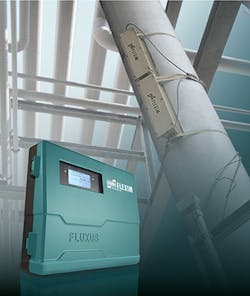Clamp-On Flow Meters Ideal For Troubleshooting, Diagnostics, Leak Detection
Flow measurement is a critical aspect of chemical processing. The effectiveness of operations depends upon accurate flow measurement data, as does maintaining compliance with regulations. Clamp-on ultrasonic flow meters can handle all types of corrosive liquids as well as gases, and are insensitive to changes in temperature, viscosity, density and pressure.
Frank Flow, chemical industry manager at FLEXIM Americas Corp.
To learn more about clamp-on ultrasonic flow meters, Chemical Processing queried Frank Flow, chemical industry manager at FLEXIM Americas Corp. FLEXIM is an Edgewood, New York-based provider of non-invasive, ultrasonic flow meters.
Q. What are the advantages of ultrasonic technology for flow meters?
A. There are a lot. I would start by stating transit time ultrasonic technology’s biggest advantage is the range or scalability of the measurement. While extremely accurate and sensitive even in low-flow scenarios, they are still able to measure high velocities. The technology is capable of catching low-velocity flows likes leaks or unseated check valves, but can also measure very high velocities you might only see on gas measurements. This massive “turn-down ratio” is unique to ultrasonic flow measurement and makes it exceedingly versatile.
Ultrasound gives you more information about the process than just flow velocity. You’ve also got the potential for an analytical measurement by measuring the sound speed of the medium along with diagnostics that provide health of the measurement or can provide a clue about other things going on inside your process.
When ultrasound is employed externally via non-invasive clamp-on meters, you have all the advantages above plus intendance of pressure and temperature variation and aggressive media. Plus, you don’t have to cut the pipe, providing safety, cost, and speed of installation advantages.
Regarding safety, FLEXIM is the only supplier of clamp-on ultrasonic systems for liquids and gases with SIL certification worldwide.
Q. What are the limitations of this technology?
A. The sound wave; it’s a mechanical wave. Something that absorbs or interferes with the wave is where you have limitations. Typically, where you’ll find something like this could be in two-phase flow. Both liquids in a gas or a certain amount of gas entrainment in liquid can absorb that signal.
[pullquote]
In measuring velocity, you need a good representative profile; and profile disturbances will influence the accuracy of these systems -- you have to take that into account.
Ultrasound is not a silver bullet technology but it can be applied to nearly any flow-measurement need that’s out there.
Q. Is it beneficial to use multiple sets of transducers with clamp-on meters?
A. That depends on the nature of the application. A single channel or a single set of transducers often work in a reflect path. So, you’ve got two beams in there providing cross-axial flow averaging. But if you’ve got poor inflow conditions or a larger pipe or something more critical, then you can add a second set of sensors to the measurement to get better averaging of the profile.
With more critical applications like check meters on gas transmission lines or applications with high value fluids, you could deploy up to four sets of sensors. Now you have eight beams through there. All still centerline to centerline with our technology, but you’ve now got a better representative profile of what’s going through there.
Q. When should you consider a clamp-on ultrasonic flowmeter for permanent installation?
A. If you can measure externally and provide a better range, a higher degree of accuracy, highly repeatable value, robust measurement, and can easily calibrate, then I would consider using a non-invasive measurement before I would consider anything else.
Clamp-on meters can make measurements better than prevailing or past technology with a higher degree of repeatability and with a higher degree of predictive diagnostics that allow you to address potential issues before the measurement stops.
The technology is different from what most people have used in the past. You have to understand where it works and where it doesn’t. But where it does work, it makes a lot of sense. The obvious case is on larger lines. Larger lines with other technology cost more as the size goes up. Whereas, a clamp-on meter’s price increase basically stops at a certain point. You get to a dual-channel flow meter and the price is capped there. It doesn’t matter if it’s on an 8-inch line or a 96-inch line, it’s the same price.
Other obvious applications include aggressive media that destroy or foul invasive technology. A good spot for clamp-on flow meters are regulated meters that require calibration and traceability because the transducers are easily removed and reinstalled vs. other technology that requires a system shutdown and/or calibration lab to certify the device.
Q. How do you determine the best location?
A. You have to consider inflow conditions and even outflow conditions. Is it coming off of an elbow or a T or out of a valve or some funky piping arrangement? These are concerns that need to be addressed.
The FLUXUS F721 features a state-of-the-art hardware design and its powerful digital signal processing surpasses any other non-intrusive ultrasonic flowmeter in terms of accuracy, reliability and versatility.
A new and innovative FLEXIM feature is a programable disturbance correction in the meter. You program the metering point distance from an elbow, and the meter corrects the profile based on laboratory studies. Considerations still need to be made for the type of disturbance, but this feature allows users to achieve better measurement certainty when profile induced error would have otherwise corrupted the calculated volume.For chemical processes, repeatability is king. Not necessarily accuracy, but it’s being able to repeatably report the same value while seeing the same flow rate. And in those cases, we might elect to move the meter toward the source of the disturbance because you get a repeatable value, which ultimately helps control the process.Q. Are there any issues with outside influences?
A. No, because most of the gear can be designed for environmental influence. We have resistance temperature detectors (RTDs) in each one of our sensors to account for differences in temperature. Let’s say you have a system out on a pipe and it’s a sunny day. One transducer is in the sun and the other one’s in the shadow. There’s a significant temperature difference between those two transducers. And, since you’re using a soundwave the temperature influences the speed of sound in the transducer block. This impacts the refraction of the wave as it travels from the transducer to the pipe and through the media. This slight change in the angle of the soundwave will be registered as flow if not corrected. If you don’t know the temperature, the meter has to assume the shift is flow related and starts to drift. FLEXIM is the only one that actually corrects for temperature effects in each transducer. This is the ASME MFC 5M standard for clamp-on meters as they are technically a refractive system as the wave form is passing through solid pipe into the fluid at non-right angle.
Q. What about maintenance?
A. There is little to no maintenance. We recommend calibration every five years for a meter where a traceability procedure is required. Transducers can be removed and calibrated back at the factory lab, or validated in the field by another certified device. As far as the device lifetime, there should be no reason these things can’t last 50 years. As long as they’re not abused or destroyed by something, it should be longer than that.
Q. What troubleshooting or other temporary duties does the clamp-flow meter suit?
A. If you think about it, only a clamp-on ultrasonic meter can be a portable device. And we have such a portable solution as well, which is nice when you just need to do a flow survey for pumps or some upsets going on in your process. It helps you get a better understanding of what might actually be going on in the process. From that standpoint, the portable device can be a great asset for temporary use, flow surveys, or the validation of other meters.
At FLEXIM, our aim is to offer you the most suitable and highest quality measuring system for your measuring task and to be a reliable partner at all times, providing you with the best possible support and service.
For more information, visit: www.flexim.com.


